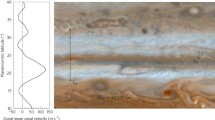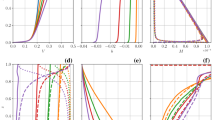Abstract
Some kinematic and dynamic structures of a microburst-producing storm in Colorado were investigated. Dual-Doppler data collected on 14 July, 1982 at 1647 MDT, during the Joint Airport Weather Studies (JAWS) project at Denver's Stapleton International Airport, were objectively analyzed to produce a three-dimensional wind field. The domain of interest had a horizontal dimension of 10 by 10 km centered on the microburst. Vertical velocities were computed by integrating the anelastic continuity equation downward from the storm's top with variational adjustment. Subsequently, fields of deviation perturbation pressure, density, and virtual temperature were retrieved from a detailed wind field using the three momentum equations.
Results show that the microburst being investigated is embedded within a high-reflectivity region associated with heavy precipitation. A strong downflow impinges on the surface producing a stagnation mesohigh inside the microburst. This mesohigh is accompanied by mesolows in the strongest outflow regions, forming a pronounced horizontal perturbation pressure gradient outward from the high-pressure center. The outflow regions extend from the surface to approximately 1 km AGL with maximum divergence in excess of 10 −2 s−1. Inclusion of friction in the pressure equation improves pressure recovery at all levels, especially in the atmospheric boundary layer (ABL). The microburst occurrence in the ABL enhances eddy transfer of momentum. Magnitudes of eddy viscosity and eddy stresses increase as a result of the microburst.
Similar content being viewed by others
References
Armijo, L.: 1969, ‘A Theory for the Determination of Wind and Precipitation Velocities with Dual-Doppler Radars’, J. Atmos. Sci. 26, 570–573.
Barnes, S.: 1973, ‘Mesoscale Objective Analysis Using Weighted Time Series Observations’, NOAA Tech. Memo. ERL-NSSL-62, 60 pp. (available from NSSL, Norman, OK, U.S.A.).
Doviak, R. J., Ray, P. S., Strauch, R. G., and Miller, L. J.: 1976, ‘Error Estimation in Wind Fields Derived from Dual-Doppler Radar Measurements’, J. Appl. Meteorol. 15, 868–878.
Fujita, T. T.: 1985, The Downburst Microburst and Macroburst, University of Chicago Press, Chicago, 122 pp.
Fujita, T. T. and Wakimoto, R. M.: 1983, ‘Microburst in JAWS Depicted by Doppler Radars, PAM and Aerial Photograph’, Preprints, 21st Conf. on Radar Meteorology, Edmonton, Canada, Am. Meteor. Soc., pp. 638–645.
Gal-Chen, T.: 1978, ‘A Method for the Initialization of the Anelastic Equations: Implications for Matching Models with Observations’, Monthly Weather Rev. 106, 587–606.
Gal-Chen, T. and Hane, C. E.: 1981, ‘Retrieving Buoyancy and Pressure Fluctuations from Doppler Radar Observations: A Status Report’, Progress in Radar Meteorology, Atmospheric Technology, NCAR, No. 13, pp. 98–104.
Gal-Chen, T. and Kropfli, R. A.: 1984, ‘Buoyancy and Pressure Perturbations Derived from Dual-Doppler Radar Observations of the Planetary Boundary Layer: Applications for Matching Models with Observations’, J. Atmos. Sci. 41, 3007–3020.
Hane, C. E. and Ray, P. S.: 1985, ‘Pressure and Buoyancy Fields Derived from Doppler Radar Data in a Tornadic Thunderstorm’, J. Atmos. Sci. 42, 18–35.
Hughes, R. H.: 1986, ‘Dynamic and Thermodynamic Characteristics of a Microburst-producing Storm in Colorado Determined from JAWS Dual-Doppler Data’, Ph.D. Dissertation, St. Louis University, St. Louis, MO, 213pp.
Kessler, E.: 1969, ‘On the Distribution and Continuity of Water Substance in Atmospheric Circulations’, Meteorol. Mongr., No. 32, Amer. Meteor. Soc., 84 pp.
Klemp, J. B. and Wilhelmson, R. B.: 1978, ‘The Simulation of Three-Dimensional Convective Storm Dynamics’, J. Atmos. Sci. 35, 1070–1096.
Lin, Y. J., Wang, T. C., and Lin, J. H.: 1986, ‘Pressure and Temperature Perturbations Within a Squall-Line Thunderstorm Derived from SESAME Dual-Doppler Data’, J. Atmos. Sci. 43, 2302–2327.
Ray, P. S., Ziegler C. L., Bumgarner, W., and Serafin, R. J.: 1980, ‘Single and Multi-Doppler Radar Observations of Tornadic Storms’, Monthly Weather Rev. 108, 1607–1625.
Roux, F., Testud, J., Payen, M., and Pinty, B.: 1984, ‘West African Squall-Line Thunderstorm Structure Retrieved from Dual-Doppler Radar Observations’, J. Atmos. Sci. 41, 3104–3121.
Srivastava, R. C.: 1985, ‘A Simple Model of Evaporatively Driven Downdraft: Application of Microburst Downdraft’, J. Atmos. Sci. 42, 1004–1023.
Wilson, J. W., Roberts, R. D., Kessinger, C., and McCarthy, J.: 1984, ‘Microburst Wind Structure and Evaluation of Doppler Radar for Airport Wind Shear Detection’, J. Climate Appl. Meteorol. 23, 898–915.
Author information
Authors and Affiliations
Rights and permissions
About this article
Cite this article
Lin, YJ., Hughes, R.G. & Pasken, R.W. Subcloud-layer kinematic and dynamic structures of a microburst-producing thunderstorm in Colorado determined from JAWS Dual-Doppler measurements. Boundary-Layer Meteorol 39, 67–86 (1987). https://doi.org/10.1007/BF00121866
Revised:
Issue Date:
DOI: https://doi.org/10.1007/BF00121866




